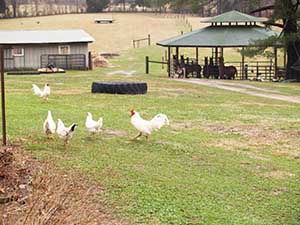Be on the Lookout for Bird Flu this Fall
 While you’re out getting your flu shot, don’t forget your precious flock. 2015 saw perhaps the biggest outbreak of the bird flu (or, highly pathogenic avian influenza, HPAI) in this country’s history. The highly contagious, easily-transferable virus affected 200 flocks this year, from commercial coops to backyard birds. It may have been responsible for a spike in egg prices this year, and was definitely responsible for the culling of many fowl. We want to make sure you’re not a sitting duck (ouch).
While you’re out getting your flu shot, don’t forget your precious flock. 2015 saw perhaps the biggest outbreak of the bird flu (or, highly pathogenic avian influenza, HPAI) in this country’s history. The highly contagious, easily-transferable virus affected 200 flocks this year, from commercial coops to backyard birds. It may have been responsible for a spike in egg prices this year, and was definitely responsible for the culling of many fowl. We want to make sure you’re not a sitting duck (ouch).
In all seriousness, ducks, geese, gulls and other wild waterfowl are the culprits here. The virus occurs naturally in waterfowl populations, and oftentimes these birds don’t even exhibit symptoms. Infected birds can transmit the virus through their saliva, nasal secretions, and feces. This is not really a public health concern. There are documented cases of humans getting the bird flu, but it’s not as easy to spread from person to person. It’s more about the chickens, turkeys and other poultry. According to the USDA, there haven’t been any documented cases in flocks since the summer, but ducks, geese, and other waterfowl will at some point be flying south for the winter (whenever autumn decides to land in central Virginia, at least). There’s a potential risk of birds spreading it to your precious poultry populations. Trust us, you don’t want this to happen. The Center for Disease Control says that HPAI rapidly affects internal organs, with a 90-100% mortality rate in as little as 48 hours. Presence of the virus warrants immediate culling of the flock, as well as surveillance of neighboring flocks. We strongly recommend practicing good biosecurity techniques if you don’t want to run afoul (oof) of this scary affliction.
Biosecurity simply has to do with the way you manage and keep your flock. It’s important to keep your birds away from strange organisms. Don’t let them interact with wild birds or even human visitors, as they may have unknowingly tracked it in. A lot of this is basic hygiene: clean your equipment, shoes, bird cages, and vehicles. If you borrow any tools from your neighbor, clean them. Or better yet, get your own, fresh from the store so you can know for sure. And you should familiarize yourself with the following warning signs so you’ll be able to take action as soon as possible.
● Are more birds dying than usual?
● Watch their movements; are your birds experiencing shakes, circling, compulsive head/neck twitching or sagging wings?
● Are the wattles, combs, and legs exhibiting a strange, purple discoloration?
● Be wary of birds that are sneezing or struggling to breathe.
● Look for nasal secretions, discolored, watery diarrhea, diminished appetite and energy.
● When your birds lay eggs, examine them. Are they normal size and shape? Are your birds laying eggs at a normal rate?
If you think your birds are infected with HPAI, there’s nothing more to be done for them. The best thing that you can do is protect other flocks (and potentially other species) from becoming infected as well. The best way to do this is to get in touch with state or federal officials. You can contact your state veterinarian or call 1-866-536-7593 to speak with the USDA. The federal government also has a biosecurity self-assessment that you can take if you want to be sure. Good luck!